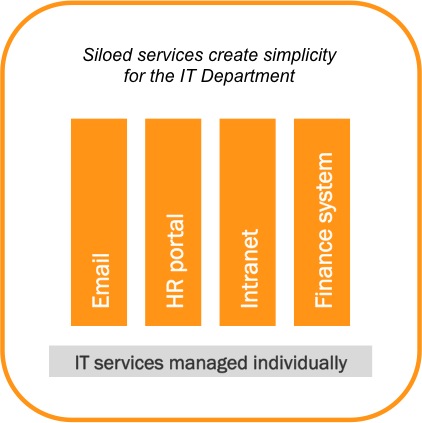Why do most organizations ignore the digital workplace?
So, in my last post we looked at what a digital workplace was and I pressed the case that every organization had one, but they are very messy and remain not very smart and joined up. One day the computer was the thing on the desk that we used when we went into work, and then suddenly things tipped in digital’s favour and then work was the computer. The computer went mobile, and with the help of his little brother the mobile phone, employees eloped with their jobs and the rest is history.
I believe the organizational structures that we put in place to cope with IT occurred just before that important transition between the old sort of workplace and the new. Organizations have a lot of IT systems but tend to ignore the idea of a digital workplace. Why is this?
Well, contrary to the message that most of you want to hear, IT is a hard, expensive, thankless task. IT teams wherever possible have tried to split its delivery into bite sizes pieces they call “Services” so they can get their heads around it. Services have owners, budgets, SLAs, OLAs, capacity management… I could go on.

The thing is, this model works really well if you only care about one system, but it doesn’t scale with complexity. The team looking after the desktop build doesn’t have to give a fig about the expenses application and the expenses application has only a tenuous accountability to the rest of the intranet. There will be hundreds of systems, as well as commodity services such as messaging and file servers plus network, security—it goes on and on—a tangle of wires that just-about-works.
The horror.
There doesn’t seem to be any attempt to try and link this together cohesively as it appears too complex.
The great tangle
Within a large multi-national company there are hundreds of different stakeholders for the digital workplace. Each stakeholder is seeking a different outcome. The result, as we know, is a mess (I like the term Goat Rodeo, but that’s me). A corporate knot of competing technology.
My hunch is that the habits that we got into in thinking about IT within organizations (inside and outside of the department itself) got stuck in the pre-digital workplace state:
- Complexity was to be thrust onto the user and the simplicity was kept for the management of systems.
- The cost of systems is kept low by getting users to spend extra time using them (known as “user experience debt”).
- Systems were turned into commodities as much as possible. IT departments love commodity software such as the Microsoft stack for desktop, servers, network, email and Office, because it returns to this state of simplicity. That’s what there is, that’s what you get, we try not to customize things, even to fix problems. (This in part explains their enthusiasm for SharePoint.)
- Vertical management of systems means that there won’t be links between them as there are disincentives to adding complexity.
- Employees working away from their desks in new working styles are seen as bizarre exceptions, and support is “best endeavours” (IT speak for “You’re on your own, mate.”)

That’s nice, so what?
There are walls everywhere: “This is the intranet, that isn’t the intranet.” “That’s another team, we don’t talk to that team.” “This is our system, go away.”
I think we can do this differently. We can’t fix all of the problems of those muddled systems, but by bringing our attention up a level, changing our perspective and making some wise interventions, we can begin to bring clarity:
- We can understand people’s new working patterns and focus on people’s needs. We can be empathetic with their frustrations and build a mental model of their motivations.
- We can step back from the single view of a system and hover just above our employee’s shoulder to see their view of their digital world and the choices they need to make in terms of devices and internally provided and external tools (some of which we will disapprove of).
- We can challenge organizational assumptions and the boundaries of teams, and start realignment with current realities. We can rewrite policy.
- We can demonstrate all of the value present in the joined-up digital workplace by measuring it, qualitatively and quantitatively.
- We can smooth the rough edges of the digital workplace by providing structure, links between useful content and data and useful ways of discovering things. We can also solve problems in the user experience.
I see a unique opportunity here. I might be biased, but I can think of a community that has had to think this way for the better part of seventeen years. A community able to deal with uncertainty and equivocality, multiple rival stakeholders and competition from outside the firewall. A community experienced and battle-scarred in the skills we need: stakeholder management, navigating the organisation, information architecture and user experience.
Hey intranet team, I’ve got a little job for you.
Related research: Digital workplace user experience
Digital workplace user experience – designing for a flexible workforce
 The digital ecosystem of applications and systems provided to employees have usually been built-up piecemeal for a desk-bound user population. The report suggests that organizations can tackle issues such as loss of productivity and reduced adoption of critical services by looking at the digital workplace through the lens of the user experience.
The digital ecosystem of applications and systems provided to employees have usually been built-up piecemeal for a desk-bound user population. The report suggests that organizations can tackle issues such as loss of productivity and reduced adoption of critical services by looking at the digital workplace through the lens of the user experience.
Categorised in: Digital workplace, Strategy & governance
